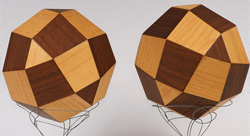Get started with Wolfram technologies, or work with us to apply computational expertise to your projects.
Questions? Comments? Get in touch: 1-800-WOLFRAM, or email us

With a doctorate in Electrical Engineering and Computer Science from MIT, George Hart is committed to a life of computers and mathematics, which, to him, means a life of art.
Hart started making polyhedra and other geometric constructions by hand as a child in the 1960s and, by college, was sculpting increasingly more complex polyhedra models with cardboard. "It was natural to me to later use Mathematica for this," Hart said. A serious Mathematica user since the early 1990s, Hart was pleased to discover the program's potential for geometric sculpture.
He visualizes the intricacies of his designs with Mathematica. With an exacting visual model, Hart is able to make precise constructions and piece them together, often by hand.
In 1998, Hart made his first piece using Mathematica and called it "Yin and Yang." This set of two hollow geometric figures, made of walnut and basswood, led to his discovery of a new family of polyhedral forms.
That same year he started work on the "Millennium Bookball," for which the New York State Council for the Arts honored him with an Individual Artist's Award. Commissioned by the Northport Public Library, this 5-foot-diameter sculpture is an assemblage of wooden facsimiles of sixty of the century's greatest books, connected by bronze rings.
Since then, Hart has made over a dozen sculptures that were first visualized in Mathematica. His work has been featured at the Long Island Museum of Science and Technology, Goudreau Museum, Vanderbilt Museum, and a number of public installations. He and his art have also been written about in numerous journals and newspapers, including the New York Times.
Hart has also published over 60 mathematical papers, authored an extensive online Encyclopedia of Polyhedra, and now teaches computer science at Stony Brook University in New York.
With his firm background in mathematics, Hart comes up with technical concepts for what he wants to create on his own. His work ranges from "Battered Moonlight," a 21-inch form of twisted steel and papier mâché inspired by Elizabeth Bishop's poem "The Man-Moth," to "Salamanders," a 30-inch-diameter construction of interconnected wooden salamanders.
"I usually start with an interesting new form and then realize it in materials in such a way that it becomes both visually and intellectually interesting," he said.
The transformation from math to art, however, is subtle for Hart. "In general, a polyhedron is not art," he says. "If I can look at it for a long time and have it continue to engage me, then I'll consider it art."